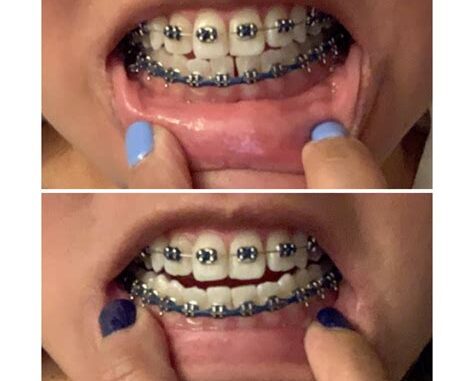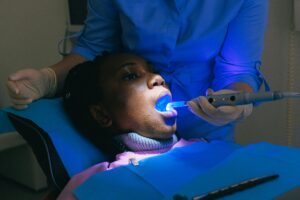
In the realm of orthodontics, power chain braces are revolutionizing the way we straighten teeth and enhance smiles. But what exactly is the science that underpins their effectiveness?
This article delves into the intricate mechanics of power chain braces, revealing how these innovative devices work to facilitate tooth movement and enhance treatment efficiency. We’ll explore the key principles driving their success, debunk common misconceptions, and present the substantial benefits power chains offer from a scientific perspective.
Whether you’re considering orthodontic treatment for yourself or simply curious about how braces work, this comprehensive guide will illuminate the fascinating world behind power chain braces and their role in achieving optimal dental alignment.
Understanding The Mechanics Of Power Chain Braces
Power chain braces utilize a sequence of interconnected elastics that cover multiple brackets, creating a continuous force that encourages the movement of teeth. This mechanism works by evenly distributing pressure across each tooth, making it an effective tool in orthodontics.
As the power chain applies consistent force on the orthodontic brackets, it initiates a response in the periodontal ligament, which surrounds each tooth. This forces the teeth to move into their correct positions over time, illustrating a key aspect of The Science behind orthodontic treatment. Unlike individual elastics, these chains can deliver varying degrees of tension depending on the needed adjustment, allowing for precise control of tooth movement.
Moreover, power chains come in various sizes and strengths, further enhancing their versatility. Each type is tailored to meet specific treatment goals, ensuring optimal alignment and aesthetic outcomes. Understanding the mechanics behind these tools confirms their role in modern orthodontics and emphasizes the intricate balance between biological processes and external forces, a vital element of The Science behind power chains.
The Science Behind Tooth Movement With Power Chains
Understanding The Science of tooth movement is crucial for comprehending how power chains function within orthodontic treatment. Power chains are made from elastic material that connects multiple brackets, applying consistent pressure across the teeth. This pressure facilitates the tooth movement necessary for aligning your smile.
The mechanics involved in this process begin when a force is applied to the teeth through the wires and brackets. Power chains distribute this force evenly, allowing for various movements, such as rotation, tipping, and bodily movement of the teeth. This is essential for achieving the desired alignment and occlusion in orthodontic patients.
At a biological level, the pressure exerted by power chains initiates the bone remodeling process. This means that as teeth shift, the surrounding bone adapts to allow for the new position of the teeth. Specific cells, known as osteoclasts and osteoblasts, are responsible for breaking down and forming bone, respectively. The science here lies in the ability of power chains to maintain optimal pressure to guide these cells effectively, thus accelerating the tooth movement process.
Moreover, the consistent force applied by power chains tends to produce more predictable results compared to traditional band elastics. This predictability is also reflected in treatment times, often leading to shorter durations for orthodontic care when power chains are used strategically.
The science behind tooth movement with power chains is a remarkable interplay of mechanical and biological processes that contribute to effective orthodontic treatment outcomes.

How Power Chains Improve Orthodontic Treatment Efficiency
Power chains play a crucial role in enhancing the efficiency of orthodontic treatments. By connecting brackets together, these elastic chains distribute force more evenly across multiple teeth, facilitating more controlled and effective tooth movement. This mechanism significantly reduces the number of adjustments needed throughout the treatment process.
The integration of power chains allows for simplified treatment plans. Orthodontists can target multiple dental issues simultaneously, such as spacing or crowding, which can lead to shorter overall treatment durations. Moreover, the consistent application of pressure helps maintain desired tooth positions, reducing the likelihood of relapse once treatment concludes.
Another key aspect of efficiency is the minimized need for additional appliances. Power chains can effectively replace or work in conjunction with other devices that may otherwise complicate treatment or extend the timeline. This combination of factors underscores the science behind the efficacy of power chains in orthodontics, showcasing their ability to streamline results while ensuring patient comfort.
Common Misconceptions About The Science Of Power Chains
When it comes to the science behind power chains, several misconceptions often arise among patients and even some practitioners. Understanding these misconceptions is crucial for appreciating the effectiveness and purpose of power chain braces in orthodontics.
One common misunderstanding is that power chains are merely used for cosmetic adjustments. While they do play a role in improving the appearance of smiles, their primary function lies in enhancing tooth alignment and addressing bite issues. Power chains apply continuous pressure to the teeth, which is essential for achieving effective and lasting results.

Another misconception is that power chains are uncomfortable and painful. While it is normal to experience some discomfort during the initial adjustment period, many patients find that this sensation quickly diminishes as they adapt to the braces. The discomfort is generally less than what is sometimes associated with traditional braces’ tightening processes.
Some people also believe that power chains are only necessary for significant orthodontic issues. However, even minor adjustments can benefit from the use of power chains. They help to close gaps and align teeth efficiently, regardless of the complexity of the case.
There’s a myth that power chains require more maintenance than other types of braces. In reality, power chains are designed to be low-maintenance. Regular follow-ups with the orthodontist ensure that they function effectively throughout the treatment period.
By debunking these common misconceptions about the science of power chains, patients can make informed decisions about their orthodontic treatment and feel more confident in the process.
The Benefits Of Power Chains: A Scientific Perspective
Power chains, an essential tool in the realm of orthodontics, offer a multitude of benefits that are underpinned by scientific principles. These continuous loops of elastic material are designed to create forces that move teeth more efficiently than traditional methods. Here are several key benefits that highlight the science behind their effectiveness:
- Enhanced Tooth Movement: Power chains provide a constant force on the teeth, which can lead to faster and more controlled movements. This is largely due to their ability to maintain consistent pressure over prolonged periods.
- Improved Aesthetic Outcomes: By aligning teeth more effectively, power chains can contribute to better symmetry and overall appearance, which is often a primary goal for many patients.
- Reduced Treatment Time: The efficiency of movement provided by power chains can lead to shorter treatment durations, as orthodontists are able to achieve desired results more quickly.
- Versatility: Power chains can be used for various types of tooth movements, including closing gaps and aligning teeth, making them highly adaptable to different treatment plans.
- Minimized Need for Adjustments: With the consistent force generated by power chains, patients may require fewer adjustment appointments compared to treatments using other orthodontic devices.
Each of these benefits is supported by the underlying science of biomechanics, emphasizing the importance of utilizing the right tools in orthodontic treatment. As advancements in orthodontic technology continue, power chains remain a crucial element in ensuring efficient and effective patient care.

Frequently Asked Questions
What are power chain braces?
Power chain braces are orthodontic devices made of elastic links that connect brackets on a dental archwire, used to close gaps between teeth and to move teeth into better alignment.
How do power chain braces work?
Power chain braces exert continuous pressure on teeth, helping to move them gradually into the desired position. The elastic chain applies force more evenly than traditional single elastic ties, facilitating more effective tooth movement.
What are the benefits of using power chain braces?
The main benefits of power chain braces include their ability to close spaces quickly, provide efficient tooth movement, and enhance the overall aesthetic of orthodontic treatment by making it less noticeable.
Are there any discomforts associated with power chain braces?
Some patients may experience mild discomfort or soreness after the application or adjustment of power chain braces, as they are designed to exert continuous pressure. This typically subsides after a few days.
How long do patients generally wear power chain braces?
The duration for which patients wear power chain braces varies based on individual treatment plans, but they are typically worn for several weeks to a few months, depending on the complexity of the orthodontic issues being addressed.
Can power chain braces be used with other orthodontic appliances?
Yes, power chain braces are often used in conjunction with other orthodontic appliances, such as metal braces, to enhance treatment effectiveness, particularly in closing gaps or correcting misalignments.
What is the care routine for patients with power chain braces?
Patients with power chain braces should follow proper oral hygiene practices including regular brushing, flossing, and avoiding sticky or hard foods. Regular visits to the orthodontist for adjustments are also crucial for optimal results.

Leave a Reply